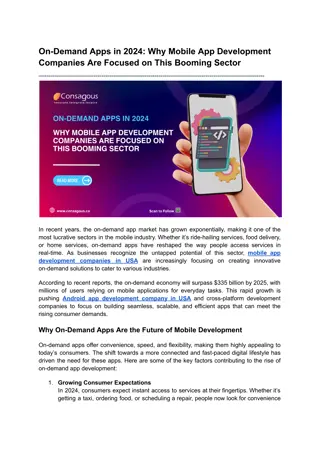Insights into India's Thriving Gig Economy and Future Work Trends
India's gig economy, spearheaded by initiatives like IWWAGE, is reshaping the future of work, particularly for women. Key questions revolve around the gig economy's impact, legislative frameworks, and COVID-19 repercussions. Academia investigates the rise of gig work, focusing on platforms like Uber and trends in the sector. The gig economy offers an alternative to traditional employment, especially for migrant workers, yet data gaps persist, and female participation remains concentrated in specific sectors. The landscape shows promise for expanding employment opportunities and flexible arrangements.
Download Presentation

Please find below an Image/Link to download the presentation.
The content on the website is provided AS IS for your information and personal use only. It may not be sold, licensed, or shared on other websites without obtaining consent from the author. Download presentation by click this link. If you encounter any issues during the download, it is possible that the publisher has removed the file from their server.
E N D
Presentation Transcript
Indias Emerging Gig Economy The Future of Work for Women Workers IWWAGE is an initiative of LEAD, an action-oriented research centre of IFMR Society (a not-for-profit society registered under the Societies Act). LEAD has strategic oversight and brand support from Krea University (sponsored by IFMR Society) to enable synergies between academia and the research centre. www.iwwage.org
The gig economy: Key questions What is the gig or digital platform economy? How it is disrupting well-defined structures? Are workers Employees/Self-employed? Experiences of gig workers? Available legislative framework for protecting the rights of gig workers? Could gig economy be a viable option for women? Impact of COVID-19 on the future of the gig economy? www.iwwage.org
Academics started to study how it works Quantifying the magnitude and growth, and; Understanding how the gig economy s rise is impacting the participation of people by offering alternative work arrangements and flexible work hours. Available literature suffers from an Uber- bias Types of platform work Micro-task crowdsourcing platforms-operate online Freelance work Both categories of work have differing skill requirements AMT CrowdFlower Clickworker Crowdwork Activities are executed in the real world and locally, but channeled online-Independent contractors California s AB5 sought to reclassify gig workers as Employees Uber/Ola Zomato/Swiggy Urban Company/Housejoy Dunzo Amazon/Flipkart Work-on- demand via App In India, gig workforce is concentrated in these aggregator companies www.iwwage.org
Rapidly expanding gig economy offers attractive alternative to conventional employment Lack of formal statistics and no reliable data on number of gig jobs created so far in India Gig economy provides employment to millions of migrant workers in urban India; has potential for generating more employment (BetterPlace, 2019) Approximately 56 per cent of new employment in India is being generated by the gig economy (Teamlease), which is inclusive of both blue-collar and white-collar manpower - Delhi is the top destination for migrant workers joining gig economy Steady expansion of the platform economy enabled by both demand for services as well as a steady supply of workers willing to take up such jobs Women s participation is increasing in the gig economy, but.. - Most jobs remain restricted to traditional segments such as domestic work, care work, beauty and wellness www.iwwage.org
Platform in focus: Urban Company Urban Company (formerly UrbanClap), founded in December 2014, is one of the largest home services start-up in India Provides end-to-end service delivery, in the hyperlocal services segment Objectives of the study to investigate: Women workers experiences, including issues of security, flexibility, labour process and pay/conditions Impact on women s empowerment and agency, and constraints within a polarised labour market Sample and Methodology Sample: 88 women service providers working with UC in Delhi in the beauty and wellness segment including spa, fitness and salon services Primary Survey + FGDs + KIIs www.iwwage.org
Demographic profile of women gig workers Marital status of the respondents Age distribtution of service providers Gig workers are millennials average age of sample: 31 years. 80% women are married, and around half of them have young children. 82% of the sample was non-migrant. 72% women had passed high school, and 21% had attended college. Flexibility and autonomy over time use are the most attractive features of the gig economy 85% respondents were satisfied with flexible timings, with 37 average work hours per week. Women with young children find the platform economy particularly attractive, as this offers the flexibility to manage the work-family balance. 2.3 35.0 1.1 29.6 29.6 30.0 25.0 18.2 20.5 20.0 15.0 10.2 10.2 78.4 10.0 5.0 0.0 Married Unmarried Divorced Widowed 20-24 25-29 30-34 35-39 40+ Educational attainment of respondents Number of children aged (0-14) years 46 71.6 80.0 50 70.0 60.0 40 50.0 28 40.0 30 30.0 20.5 20 20.0 20 4.6 3.4 10.0 0.0 6 10 Middle school (Class 6-8) High school (Class 9-12) Graduate Diploma 0 0 1 2 3 www.iwwage.org
Finding work and Earnings Number of services provided per day 56.8 60.0 50.0 57% women reported that they service less than three calls per day and 42% of respondents service between three to five calls each day Gig work was the primary source of family s income for 60% of our respondents. These women are crucial economic actors and provide critical financial support to their families. Average daily earnings are Rs. 1,552. Informal social networks are important for entering the gig space: 74% of the respondents utilised their personal networks in finding their current jobs. Under recruitment process - each professional undergoes multiple levels of screenings, mandatory for all partners. 42.1 40.0 30.0 20.0 10.0 1.1 0.0 More than 5 times a day 3-5 times a day Less than 3 times a day After careful and exhaustive selection procedure, each woman partner has to undergo an induction training for 10 days. They are trained to do everything from packing and unpacking the Urban Company kit bags, to navigating the platform smoothly using their mobile phones, and client interface . and training is www.iwwage.org
Womens empowerment and increased autonomy Our survey findings revealed that gig economy helps women workers gain financial independence. It provides avenues which are not only economically empowering but also changing their relative position within the family. Women enjoy a higher status and improved decision-making power. One woman participant shared that, I was married into a family where I was asked to cover my face with a veil. When I was asked to come for a training at UrbanClap, I had to wear trousers and my mother-in-law asked me to wear the traditional attire or move out of the house. I lived with my maternal family until I completed my training. I joined UrbanClap only six months back, and since then I earn well, my mother-in-law has taken me back with all due respect . Training Head of Urban Company mentioned The beauty of the gig economy is the flexibility that it offers, especially for our female partners. For instance, a lot of female partners are married with children, they like to offer their services when their children go to school i.e. the first half of the day, there are others who want to work in the latter half of the day. Each partner has the option to log in and log off the platform at their will. They just need to mark it on the app. www.iwwage.org
Challenges faced by service providers In general - no safety nets for gig economy workers UC extends medical cover to its partners, and 90% have even utilized/benefitted from it, but are not entitled to any other benefits. 53% of the surveyed gig workers were subjected to penalties for declining jobs. Control over labour is exerted via automated rating and review mechanisms - permitting platform to exclude poorperformers . 100.0 93.1 90.9 85.1 85.1 90.0 83.9 80.0 73.6 70.8 70.0 48.2 58.6 60.0 48.3 50.0 38.0 40.0 26.4 30.0 23.8 14.3 20.0 13.3 13.3 8.0 6.1 10.0 0.0 Training received Support in terms Opportunities for learning Maternity benefits Insurance benefit Incentive and increment systems Flexible timings Experience dealing Access to customer base of inputs/materials used % Satisfied % Dis-satisfied www.iwwage.org
In Conclusion Positives Women are the beneficiary of the gig ecosystem offers choice of work and financial independence Women enjoy a higher status and improved decision-making power within the family Platforms offer choices to women, who in the absence of these, and the precarity of informal work, choose to not participate in any economic activity Negatives Disappearance of employer-employee relations has a deep impact on labour structures Access to benefits, safety, increased and consistent earnings, increasing competition, lack of effective bargaining power are major challenges Recommendations Adequate labour protection measures; fundamental rights of freedom of association and collective bargaining More research to fully understand how gig work fits into the broader labour market and to understand actual (best) practices adopted in different platforms within the service sector www.iwwage.org
ruchika.chaudhary@iwwage.org www.iwwage.org























